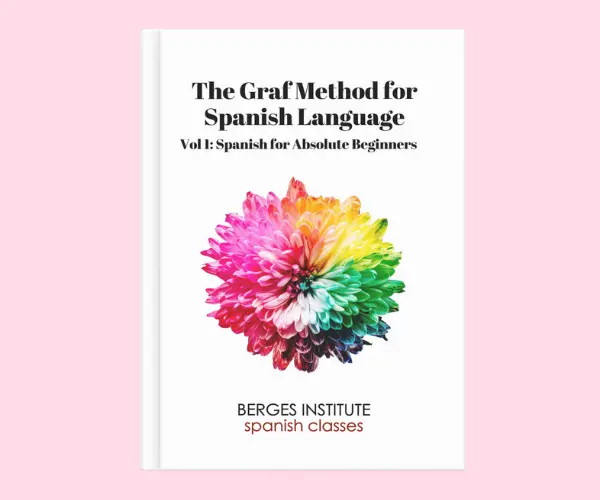


In this volume, we discuss the alphabet, definite and indefinite articles, and verbs ser and estar, among other topics.
¿Alguna vez has estudiado el presente perfecto? (Have you ever studied the present perfect?) ¿Has estado en España? (Have you ever been to Spain?) ¿Has hecho ejercicio esta mañana? (Have you exercised this morning?) These are just three examples of the present perfect tense also called presente perfecto or pretérito perfecto compuesto in Spanish. I am sure you have heard about the present tense (an action happening now or an action or even that regularly happens), but what is the present perfect tense?
In this article you will learn all about the present perfect tense: how to form it, when to use it, common regular and irregular verbs in the past participle form, some time expressions used with this tense, and at the very end you’ll have the chance to practice what you learned!
Sounds good? Let’s get started!
The present perfect is a compound tense, which means it is formed with two verbs: the present indicative tense of the auxiliary verb haber and the participio (past participle) of the main verb. An auxiliary verb, also called a helping verb, is a verb that adds functional or grammatical meaning to the clause in which it occurs. It provides the information of person, number, tense and mood. An auxiliary verb does not have meaning by itself (*Yo he), it normally accompanies an infinitive or participio. In English we have many helping verbs (can, will, have, are, must, will be, do, had, has,...) and just like haber, some of them cannot be used independently, and they will always be followed by the main verb, the verb they are helping.
The participio of regular verbs in Spanish is formed by adding -ado to -ar verbs and -ido to -er and -ir verbs. In English, we also form the present perfect tense using two verbs: the present tense of the verb to have plus the past participle of the main verb (adding -ed for regular verbs: I have worked, she has cooked), so it is very similar to Spanish.
¡Ojo! Generally, the past participle is used to form compound tenses such as the present perfect; however, past participles can also be used as adjectives which means they have to agree in gender and number with the noun they are modifying:
Present Perfect tense: He roto las gafas. (I have broken my glasses.)
Past participle as an adjective: Las gafas están rotas (My glasses are broken.)
Let’s learn how to conjugate the present perfect tense. Here is the formula:
Subject + Present Indicative of haber + Participio of main verb
Here’s the conjugation of haber in the present indicative tense:
Yo he
Tú has
Él/Ella/Usted ha
Nosotros/Nosotras hemos
Vosotros/Vosotras habéis
Ellos/Ellas/Usteded han
¡Ojo! Remember that haber by itself cannot be used, it doesn’t have meaning on its own.
Now, let’s see how to form the past participle of some regular verbs:
Estudiar: estudi + ado = estudiado
comer: com + ido = comido
vivir: viv + ido = vivido
Here are some examples:
Yo he estudiado (I have studied.)
Tú has comido (You have eaten.)
Él/Ella/Usted ha vivido (He/She has lived. You have lived.)
Nosotros/as hemos trabajado (We have worked.)
Vosotros/as habéis bebido (You (all) have drunk.)
Ellos/as/Ustedes han dormido (They/You have slept.)
¡Ojo! Any time that you see perfect as part of the name of a tense (present perfect, past perfect, future perfect, etc.) it means it is a compound verb, and you will be using an auxiliary verb, haber, plus the main verb. For example, to conjugate the future perfect tense you will need to conjugate the verb haber in the future indicative plus the participio of the main verb.
Let’s see more examples:
Mi madre me ha llamado esta mañana.
(My mom has called me this morning./ My mom called me this morning.)
Me he despertado tarde hoy.
(I have woken up late today./ I woke up late today.)
Eva nunca ha estado en California.
(Eva has never been to California.)
Nosotros hemos tenido un examen esta semana.
(We have had a test this week./ We had a test this week.)
¡Ojo! In American English, the past simple tense is used more often than the present perfect, so in the previous examples you may find it strange or even a bit unnatural to use the present perfect instead of just the past simple tense. Same thing happens in Latin America. In general, people tend to use the past simple tense or pretérito more often than the present perfect, which is more frequently used in Spain.
For example:
In the United States and Latin America it’s more common to ask someone:
Did you eat today? ¿Comiste hoy?
However, in British English and Castilian Spanish, people prefer the present perfect tense:
Have you eaten today? ¿Has comido hoy?
What about irregular verbs? Because irregular verbs do not follow the rules for the rest of verbs, you have to memorize them. Most of the irregular past participles in Spanish end in -to or -cho. In English, we have plenty of irregular participles that cannot be formed by adding -ed: bring-brought, eat-eaten, go-gone, break-broken, write-written, etc.
Let’s take a look at the most common irregular verbs in the past participle form:
¡Ojo! Did you know that freír, proveer, and imprimir are the only verbs in Spanish that have two participles, one regular and the other irregular? freír (freído/frito), proveer (proveído/provisto), and imprimir (imprimido/impreso).
¡Ojo! Did you notice that all the irregular verbs are either -er or -ir verbs?
Let’s take a look at some examples using irregular verbs:
Sol y Francisco ya han vuelto de sus vacaciones.
(Sol and Francisco have already returned from their vacation.)
¿Has escrito la carta?
(Have you written the letter?)
¿Alguien ha abierto la ventana? ¡Hace frío!
(Has anyone opened the window? It's cold!)
Los estudiantes no han hecho la tarea hoy.
(The students have not done their homework today.)
Ya hemos visto esta película.
(We have already seen this movie.)
¡Ojo! As you can see in one of the examples above, to form a negative sentence, we place no before the verbs that form the present perfect, never in between (Los estudiantes no han hecho la tarea hoy).
Now that you know how to form the present perfect tense using the present simple tense of the verb haber plus participio, do you know when to use it? The present perfect can be a bit confusing because although the word present is part of its name, it is actually a past tense that has an effect or result in the present. The present perfect is commonly used to talk about your life experiences (what you have or haven’t done), past actions which started in the past and are still happening now, or for finished actions that are still related or have a connection to the present. Let’s see some examples:
Yo he estado en el desierto de Sahara.
(I’ve been to the Sahara desert.)
Evaristo y su hija han visto a Michael Jackson en concierto.
(Evaristo and his daughter have seen Michael Jackson in concert.)
¡Mi amiga nunca ha probado sushi!
(My friend has never tried sushi!)
In the previous examples, we used the present perfect tense to talk about actions that happened in the past but have relevance in the present tense; they are still the person’s life experiences.
¡He perdido mi móvil!
(I’ve lost my cell phone! or I lost my cell phone!)
Eloísa ha hecho una tortilla española para cenar.
(Eloísa has made a Spanish tortilla for dinner or Eloísa made a Spanish tortilla for dinner.)
Alan ha ido al gimnasio esta mañana.
(Alan has gone to the gym this morning or Alan went to the gym this morning.)
In these examples, although the actions occurred in the past, they have a result in the present. In the first example, the speaker lost their phone and still doesn’t have it, therefore, they cannot make phone calls/send messages; the past action is affecting the present. In the second example, Eloísa made a Spanish tortilla (omelet) but she is about to eat it, it still has a result in the present. In the third example, Alan went to the gym earlier today, it is a recent action that may have an effect in the present: Alan may be tired or sore from his workout.
¿Lo has entendido?
Don’t confuse the present perfect with the past simple, the past simple tense is used for past events or actions which have no connection to the present. Let’s take some of the previous examples using the past simple instead:
Yo fui al desierto de Sahara en el año 2008.
(I went to the Sahara desert in 2008.)
Evaristo vio a Michael Jackson en concierto hace casi 30 años.
(Evaristo saw Michael Jackson in concert almost 30 years ago.)
El mes pasado perdí mi móvil, así que tuve que comprarme otro.
(I lost my cell phone last month, so I had to buy another one.)
Eloísa hizo una tortilla española anoche para cenar.
(Eloísa made a Spanish omelet last night for dinner.)
Fun fact! ¿Alguna vez has probado la tortilla española? It is a traditional dish from Spain. It is made with eggs and potatoes, some people add onions as well. It’s an easy and delicious dish! You can have it hot or cold, by itself, as a side dish, or even in a sandwich!
When we talk about the present perfect, we do not use the same time expressions as we do with the past simple (for example: ayer, anoche, el año pasado, hace 5 años,...). Instead, we will use expressions such as hoy (today), esta mañana (this morning), esta semana (this week), este mes (this month), este año (this year), ya (already), todavía (yet), alguna vez (some time), etc. Note that the past simple can use these expressions when referring to completed actions. As you can see, all these expressions refer to actions that have happened very recently (this morning, this month...).
¡Ya casi hemos terminado! In today’s article you learned about the present perfect tense. You learned how to form it using the present indicative tense of the verb haber plus the past participle or participio of the main verb. You also learned when to use the present perfect (past experiences, past actions connected to the present). We covered the main difference between the past simple (specific and completed actions in the past) and the present perfect tense. We saw plenty of examples using the present perfect tense and also, some time expressions (esta mañana, este mes...). To recap: the present perfect is a past action which is still relevant in the present, it has a connection or a direct effect or result in the present.
Are you ready for some practice?
***********************
Answer Key:
***********************
Answer Key:
***********************
Answer Key:

Alicia Fernández is a content writer at Berges Institute.
